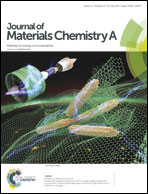Sustainable seaweed-based one-dimensional (1D) nanofibers as high-performance electrocatalysts for fuel cells†
Abstract
A high-performance one-dimensional (1D) nanofibrillar N–Co–C oxygen reduction reaction (ORR) catalyst was fabricated via electrospinning using renewable natural alginate and multiwalled carbon nanotubes (MWCNTs) as precursors, where Co nanoparticles (NPs) are encapsulated by nitrogen (N)-doped amorphous carbon and assembled on MWCNTs. The 1D morphology not only prevents the aggregation of the Co NPs, but also provides a typical multimodal mesoporous structure which is beneficial for the O2 diffusion and the migration of adsorbed superoxide. In combination with the high conductivity of CNTs, the N-doped amorphous carbon shell can exert electron release on the encapsulated Co NPs, and thus enhance the ORR activity. It is also a protective layer that stabilizes the Co NPs, which ensures a high ORR activity of the catalysts in both alkaline and acid media and long-term durability. So compared with a commercial Pt/C catalyst, as expected, the N–Co–C nanofiber reported herein exhibited a comparable current density and onset potential (−0.06 V), with better durability in alkaline and acid solutions and better resistance to crossover effects in the ORR.


 Please wait while we load your content...
Please wait while we load your content...